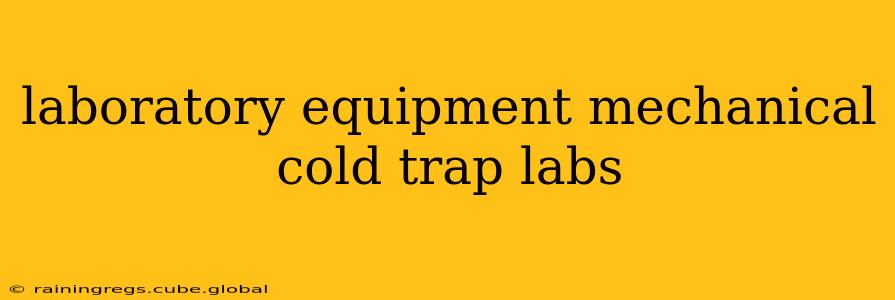Maintaining a clean and efficient laboratory environment is paramount for accurate results and safety. One crucial piece of equipment often overlooked, yet vital for many applications, is the mechanical cold trap. These devices play a critical role in various laboratory procedures, preventing contamination and protecting sensitive instruments. This comprehensive guide explores the world of mechanical cold traps, delving into their function, types, applications, and maintenance.
What is a Mechanical Cold Trap?
A mechanical cold trap, unlike its cryogenic counterpart, utilizes a refrigeration system to achieve low temperatures, typically ranging from -40°C to -80°C. These traps are designed to condense and retain volatile vapors, gases, or other unwanted substances during processes like vacuum distillation, freeze-drying, and chemical synthesis. This prevents these substances from reaching sensitive pumps or contaminating other parts of the system. They're a crucial component for maintaining vacuum integrity and ensuring the purity of experimental results.
How Does a Mechanical Cold Trap Work?
The operation is relatively straightforward. The system's internal components, usually a coiled or serpentine condenser, are cooled by the refrigeration unit. As vapors or gases pass through the chilled condenser, they lose kinetic energy and transition into a liquid or solid state, thereby condensing and accumulating within the trap. The condensed materials can then be safely removed and disposed of according to appropriate laboratory protocols.
What are the Different Types of Mechanical Cold Traps?
Several types cater to diverse lab needs. The distinctions often lie in their size, capacity, cooling method, and materials of construction. Common variations include:
- Recirculating Chiller-based Traps: These utilize a separate recirculating chiller to provide cooling, offering precise temperature control and flexibility.
- Integrated Refrigeration Units: These have the refrigeration system built directly into the trap, providing a compact and self-contained solution.
- Different Condenser Designs: The condenser's design can vary—some are simple coils, while others may feature more complex geometries to maximize surface area and cooling efficiency. The material of construction (stainless steel, glass) also differs depending on the application.
What are the Applications of Mechanical Cold Traps in Labs?
Mechanical cold traps are invaluable in numerous laboratory settings and applications:
- Vacuum Distillation: Preventing volatile solvents from reaching and damaging the vacuum pump.
- Freeze-Drying (Lyophilization): Removing water vapor from samples during the freeze-drying process.
- Chemical Synthesis: Condensing and trapping byproducts or reactive gases to maintain a clean reaction environment.
- Gas Purification: Removing impurities or unwanted gases from a gas stream.
- Protecting Sensitive Instruments: Preventing contamination of mass spectrometers, gas chromatographs, and other sensitive equipment.
What are the Advantages of Using a Mechanical Cold Trap?
Mechanical cold traps offer several key benefits over other methods of vapor trapping:
- Temperature Control: Precise temperature control ensures efficient condensation and prevents potential issues associated with uncontrolled temperature fluctuations.
- Safety: Reduces the risk of contamination and damage to equipment and personnel.
- Ease of Use: Generally easier to operate and maintain compared to cryogenic traps.
- Cost-Effectiveness: Many models provide a cost-effective alternative to cryogenic cooling systems in various applications.
How Do I Maintain a Mechanical Cold Trap?
Regular maintenance is crucial for optimal performance and longevity. Key maintenance practices include:
- Regular Cleaning: The trap should be cleaned regularly to remove accumulated condensed materials. The cleaning procedure will vary based on the material being trapped and the trap’s construction.
- Inspecting for Leaks: Regular checks for leaks in the system are essential to ensure proper function and prevent loss of vacuum.
- Refrigerant Monitoring: For traps with integrated refrigeration units, regular monitoring of the refrigerant level is necessary.
What are the Safety Precautions When Using a Mechanical Cold Trap?
- Always follow the manufacturer's instructions for operation and maintenance.
- Use appropriate personal protective equipment (PPE), such as gloves and eye protection.
- Ensure adequate ventilation in the laboratory.
- Properly dispose of any condensed materials according to laboratory safety protocols.
Conclusion
Mechanical cold traps are indispensable pieces of equipment in a wide range of laboratory settings. Their ability to efficiently condense and trap volatile substances is critical for maintaining a clean, safe, and productive laboratory environment. Understanding their function, maintenance, and safety procedures is essential for any researcher utilizing these invaluable tools. Choosing the right mechanical cold trap depends heavily on the specific application and the types of substances being handled. Always consult with laboratory professionals and equipment suppliers to determine the optimal model for your needs.
